

The Silent Stakeholder: Why Trauma Needs to Be Considered When Planning Change. As an organization change strategist who has been working with clients for the past 30 years to help roll out new technologies or install new post-merger cultures, I’ve seen millions of wasted dollars occur because true adoption did not take hold.
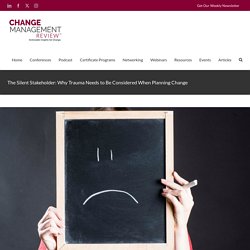
While the root causes are various, one core reason can be attributed to the failure to consider and support the whole person–physical, emotional and spiritual–when working with stakeholders. As change strategists, one of the first steps we take when working to implement a significant change is to conduct a stakeholder analysis.
We identify a list of the individuals, functions and departments that will be impacted. Podcast: The Silent Stakeholder, With Tricia Steege. Podcast: Play in new window | Download Subscribe: Apple Podcasts | What we don’t know about our employees may be one of the keys to why so many of our change initiatives fail to deliver on their promises.
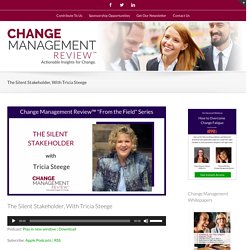
In this episode of the Change Management Review podcast, Managing Editor Brian Gorman discusses the role of trauma in change. Tricia Steege, who has done significant research in this area, identifies trauma as “the silent stakeholder.” Approximately 25% of adults have experienced four or more adverse childhood events, according to a study by the CDC and Kaiser Permanente. LinkedIn by Sean McPheat. Stakeholder mapping. How Strategic HR Partners Support Critical Workplace Changes. For many organizations, the human resources (HR) function is shifting from being a tactical function to a strategic partnership—with HR professionals having a seat at the table and helping the organization make decisions about products, functions, roles and other critical workplace changes.
Return-to-The-workplace Changes Nowhere has the shift from tactical HR to strategic HR been truer than with return-to-the-workplace planning and initiatives. Whether an organization is experiencing change disruption, an organizational redesign, or a shift in culture, leaders increasingly rely on the people-focused insights and change-enabling skillsets of strategic HR partners to elevate success with critical workplace changes.
Change saturation and disruption In change management, saturation is generally defined as how much change an individual or a group or an organization can handle. Comprehensive Guide to Impact Partnerships. Five steps to stakeholder capitalism. At a time of change—which means all the time—resilient companies do better, getting hurt less during downturns and then coming out stronger compared with the competition.
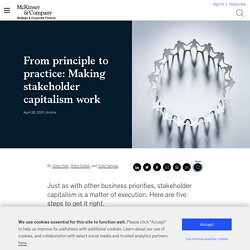
Resilient companies are prepared for bad times, are relentless about improving performance, and make decisions skillfully. An additional element can knit all of these attributes together into a stronger whole—“stakeholder capitalism.” Video McKinsey senior partner Dame Vivian Hunt describes key insights from this article. Tool: STAKEHOLDERS MAP AND COMMUNICATIONS CALENDAR.
Tools: USEFUL TOOLS FOR MANAGING STAKEHOLDERS. Guide to Dynamic Stakeholder Mapping. By Sense & Change Here is the first version of the Guide to Dynamic Stakeholder Mapping, including a thorough concept explanation, an overview of its practical use cases and guidance for deciding where to apply it in your work.Contents* About the tool: 1 min read* The creation story: 1 min read* Why use the tool: 1 min read* Tool details - map layers: 8 min read* How to use the tool: 2 min read* When to use the tool: 1 min read* When not to use the tool: 1 min readEnjoy!

Raluca & Bülent, the Sense & Change team Sorry, this item is not available in your location. Don’t Over-Look Stakeholder Management in Change Management. My previous blog analyzed executive alignment in a change management initiative.
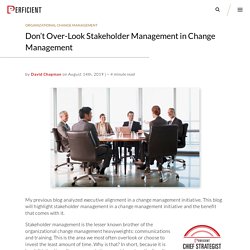
This blog will highlight stakeholder management in a change management initiative and the benefit that comes with it. Stakeholder management is the lesser known brother of the organizational change management heavyweights: communications and training. NEW Stakeholder Analysis Tool for Change Management Projects.
We have launched a cool web-based app for Stakeholder Analysis which is integrates into both our COHORT (Change Management) and CHAPTER (High Performing Teams) simulations.
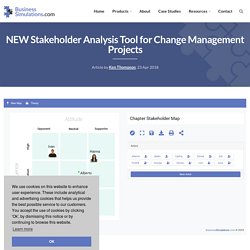
A standalone on-line version of the Stakeholder Analysis App is also FREELY available for use with Change Management projects in your own organization. Stakeholder Analysis 101 Stakeholder Analysis or Stakeholder Mapping is a simple technique which should be used at the beginning of major programmes involving any kind of significant change. Stakeholder Mapping allows you to analyse the key "Stakeholders" (i.e. Actors) who might either be impacted by or have an interest in the programme. Harvard Law School Forum on Corporate Governance by Lucian A. Bebchuk and Roberto Tallarita. Corporate purpose is now the focus of a fundamental and heated debate, with rapidly growing support for the proposition that corporations should move from shareholder value maximization to “stakeholder governance” and “stakeholder capitalism.”
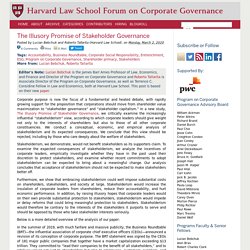
In a new study, The Illusory Promise of Stakeholder Governance, we critically examine the increasingly influential “stakeholderism” view, according to which corporate leaders should give weight not only to the interests of shareholders but also to those of all other corporate constituencies. We conduct a conceptual, economic, and empirical analysis of stakeholderism and its expected consequences. We conclude that this view should be rejected, including by those who care deeply about the welfare of stakeholders. Stakeholderism, we demonstrate, would not benefit stakeholders as its supporters claim. Conduire le changement dans son entreprise : comment mobiliser efficacement ses parties prenantes ! Revisiting the Business Roundtable's 'Stakeholder Capitalism,' one year later. The Illusory Promise of Stakeholder Governance (2020)
Abstract Corporate purpose is now the focus of a fundamental and heated debate, with rapidly growing support for the proposition that corporations should move from shareholder value maximization to “stakeholder governance” and “stakeholder capitalism.”
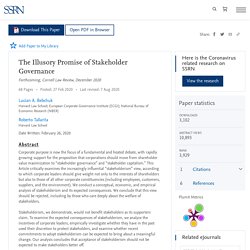
This Article critically examines the increasingly influential “stakeholderism” view, according to which corporate leaders should give weight not only to the interests of shareholders but also to those of all other corporate constituencies (including employees, customers, suppliers, and the environment). We conduct a conceptual, economic, and empirical analysis of stakeholderism and its expected consequences. How to Reconcile Your Shareholders With Other Stakeholders. 1.

Business Roundtable, “Statement on the Purpose of a Corporation,” Aug. 19, 2019, 2. Factors for external stakeholder engagement. Fostering strong relationships with communities, customers, owners, and other groups of external stakeholders can help companies understand and meet their needs.
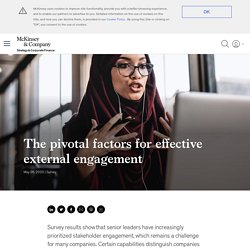
In crises like the COVID-19 pandemic, when stakeholders look to companies for support and governments step in to aid the business community, managing external relationships becomes even more important. Our latest McKinsey Global Survey on external engagement, which was conducted before the pandemic, found that senior executives recognized the need to engage stakeholders and were increasingly focused on their companies’ efforts in this area. Nearly 60 percent of respondents said the topic ranks among their CEOs’ top three priorities. Change Recipient Versus Stakeholder. Resistant Stakeholders: Dealing With the Good, the Bad and the Ugly. George Jucan - February 5, 2020 George Jucan is an experienced Project Manager Professional (PMP) with 20 years of technical and management experience in complex environments, both in public and private sector. He is well known in the project management community as a successful IT project management consultant, speaker at public events, trainer and author of project management articles.
Even before stakeholder management was introduced as a new knowledge area in A Guide to the Project Management Body of Knowledge (PMBOK® Guide)—Fifth Edition, there were many discussions within the project management community about project stakeholders—and rightfully so, because despite all of the machines, tools, techniques and methodologies, at the end of day projects are done… by people (team) with people (partners) and for people (clients) We Are Nowhere Near Stakeholder Capitalism. Executive Summary Have corporations fundamentally changed their raison d’être from creating value for shareholders to benefiting society-at-large?
The authors say no. We haven’t seen real change yet, and we won’t without first transforming firms’ performance measurement systems. CEOs continue to be hired, fired, and compensated based on metrics, such as revenues, profits, and share prices. Davos: The stakeholder capitalism debate is over. This is the web version of CEO Daily. To get it delivered to your inbox, sign up here. Good morning. Making Stakeholder Capitalism a Reality. Executive Summary Spurred by the climate crisis and increasing social challenges, such as rising inequality, the stakeholder capitalism movement is gaining steam, leaving us to grapple with two tough questions: 1) How can groups across the socio-economic and political divides get better aligned on the current reality we’re facing? And 2) What is the appropriate approach, including taxation and regulation strategies, to produce the economic, environmental, and social outcomes we need to survive and thrive for years to come?
If business leaders don’t help answer these questions, they run the risk of getting answers foisted upon them. The authors suggest leaders start within their companies, by measuring the right performance indicators, being a thoughtful voice for regulation, painting an integrated picture for shareholders and not being afraid of taking on risks. Naysayers will call stakeholder capitalism a PR stunt. Strategy talk: Does shareholder value still have a place in strategy? How to Connect with Project Stakeholders Through Social Media. Stakeholder (corporate) - description. How to convey the size of changes to your stakeholders? Change Management for your project: A guide to stakeholder analysis. Building Stakeholder Support for Organizational Change.
How Customer Obsession Creates Accountability for Change. Study: Difficult stakeholders.